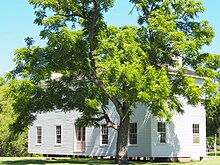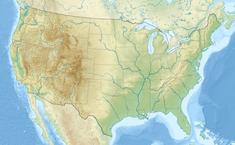Levi Jordan Plantation State Historic Site
This article needs additional citations for verification. (May 2021) |
| Location | 7234 FM 521, Brazoria, Texas |
|---|---|
| Coordinates | 28°59′57″N 95°38′54″W / 28.99917°N 95.64833°W |
| Designated | 2001 |
| Built | 1848-–1851 |
| Architect | Levi Jordan |
| Architectural style(s) | Greek Revival |
| Governing body | Texas Historical Commission |
| Website | Levi Jordan Plantation State Historic Site |
| Designated | 1967 |
| Reference no. | 9570 |
The Levi Jordan Plantation is a historical site and building, located on Farm to Market Road 521, 4 miles (6.4 km) southwest of the city of Brazoria, in the U.S. state of Texas. Founded as a forced-labor farm worked by enslaved Black people, it was one of the largest sugar and cotton producing plantations in Texas during the mid-19th century, as well as a local center of human trafficking.[1]
It was designated as a Recorded Texas Historic Landmark in 1967.[2] The University of Houston's Department of Anthropology and Professor Kenneth L. Brown has done many years of research at this plantation.[3]
Levi Jordan
[edit]Levi Jordan (1793–1873), a Georgia-born planter, traveled in 1848 to Brazoria County, Texas, bringing with him twelve enslaved Black people.[3] Previously, Jordan had owned adjoining plantations on the Louisiana-Arkansas border (Union County, Arkansas) with his son-in-law, James Campbell McNeill,[2] however he was not as successful as he wanted to be. Jordan purchased 2,222 acres (899 ha) of Brazoria County land from Samuel May Williams.[3][4] Levi Jordan was married to Sarah (née Stone), together they had one daughter named Emily.[5]
Shortly thereafter, Jordan returned to Arkansas to sell his earlier plantation. He also traveled to Louisiana, where Jordan’s daughter Emily, his son-in-law James Campbell McNeil, and his grandchildren resided, to sell that land so they could all pack up and move to Texas. Jordan wanted to develop a land that would survive many generations and “outlive” him, according to the oral history of the family. During the time that Jordan was traveling back to Arkansas and Louisiana to tie up loose ends, the 12 enslaved people that Jordan took to Texas stayed behind in order to get the land ready for development.
After Jordan’s death in 1873, the land was split between Jordan’s grandsons’ J. C. McNeill and C. P. McNeill, according to his will. Jordan had also purchased one of two sugar plantations formally belonging to the Rowe family, which was also left to his grandsons.[5] His granddaughter Annie McNeil Martin was cut out of the will, and she was not allowed on the property without the permission of Jordan’s wife, Sara Jordan.[clarification needed]
Plantation history
[edit]
Plantation house
[edit]The initial construction of the plantation included the new family home, slave quarters, and ancillary buildings.[6] On the property is Jordan's former residence, the Jordan House, is a two story Greek Revival-style plantation house built between 1849 and 1851.[4][7][8] The family house was built with yellow long-leaf pine lumber that was imported from Florida.[5] Jordan's enslaved workers hand-hewed the window sills and studs of the house from local oak lumber and they handmade bricks for the fireplaces.[5]
Plantation farm
[edit]Sugar cane was the primary cash crop during the beginning of the plantation. Jordan built the largest sugar factory in Brazoria County, which was used by himself and neighboring planters. Sugar cane cultivation no longer possible at the Levi Jordan Plantation after the end of the American Civil War in 1865 and during the Reconstruction era.[4] Levi Jordan and Levi Jordan's great-grandsons converted the land into a cotton plantation and employed many of the formerly enslaved people and their descendants as sharecroppers, to work and maintain the cotton fields.[4]
Slave cabins
[edit]The cabins first served as slave quarters, and were located northwest of the Jordan House.[4] It is believed that by 1860, Jordan's plantation had more than 130 slaves that had worked there and some had been born in Africa.[9] The cabins were used by workers until 1887, when they were abandoned.[9] The cabins no longer physically exist as buildings, however through archaeological excavation researchers were able to find many of the remnants of former workers and piece together a better understanding of their history.[9][10] More than 600,000 artifacts have been found on the property.[10]
Levi Jordan Plantation State Historic Site (2001 – present)
[edit]The site was owned, until 2001, by several site descendants. The Houston Endowment purchased the 90 acres of the former plantation from Dorothy Cotton and in the spring of 2002, donated it to Texas Parks and Wildlife.[10] It is owned by the Texas Historical Commission and is managed by Texas Parks and Wildlife, as the Levi Jordan Plantation State Historic Site.[10][9]
The Levi Jordan Plantation Historical Society, a local advocacy group and 501(c)3 organization, was created in 1993,[11] and its membership includes site descendants and other community members. This group was founded with the assistance of Kenneth L. Brown (the principal archaeological investigator and a University of Houston anthropologist).[9][12] Carol McDavid, a former graduate student of Kenneth L. Brown, worked with the local community to create a web site about the archaeology.[13]
Texas proposition 8 (in 2003) allowed for the financing of the restoration of the property.[10] Starting in 2012, the plantation house was restored.[7] As of November 2015, the site is only open to the public for Saturday tours.[14]
See also
[edit]References
[edit]- ^ Marshall, Lydia Wilson (2015). The Archaeology of Slavery: A Comparative Approach to Captivity and Coercion. SIU Press. pp. 12, 167, 171, 187. ISBN 978-0-8093-3397-4.
- ^ a b "Levi Jordan Plantation". Texas Historical Commission. Retrieved 9 February 2012.
- ^ a b c Emery, Mike (February 16, 2010). "UH Anthropologist Ken Brown Uncovers West African Customs at Texas Plantation". University of Houston. Retrieved 2021-06-21.
- ^ a b c d e Moorhead, Gerald (2018-09-20). "Levi Jordan Plantation State Historic Site". SAH Archipedia, Society of Architectural Historians. Retrieved 2021-06-21.
- ^ a b c d Kleiner, Diana J. "Jordan, Levi". Texas State Historical Association (TSHA). Retrieved 2021-06-21.
- ^ "Levi Jordan Plantation State Historic Site". Independence Trail Region. Retrieved 2021-06-21.
- ^ a b "Restoring Levi Jordan Plantation". Chron. 2012-03-03. Retrieved 2021-06-21.
- ^ "Details - Levi Jordan Plantation - Atlas Number 5039009570". Atlas: Texas Historical Commission. Retrieved 2021-06-21.
- ^ a b c d e Turner, Allan (2010-02-23). "Brick uncovers story of African culture in Brazoria". Chron. Retrieved 2021-06-21.
- ^ a b c d e Patton, Rachel (2003-07-10). "Work at Levi Jordan plantation slowed by freeze on state funding". Chron. Retrieved 2021-06-21.
- ^ McDavid, Carol (1997-09-01). "Descendants, decisions, and power: The Public Interpretation of the archaeology of the levi jordan plantation". Historical Archaeology. 31 (3): 114–131. doi:10.1007/BF03374235. ISSN 2328-1103. S2CID 53309370.
- ^ Powell, Julie (July 2003). "Back to the Old Place". Archaeology Magazine (Volume 56, Number 4). Archaeological Institute of America. Retrieved 2021-06-21.
- ^ Carter, Alice (1999). "The Levi Jordan Plantation". The Journal for MultiMedia History, Volume 2. University at Albany. Retrieved 2021-06-21.
- ^ Levi Jordan Plantation State Historic Site
Further reading
[edit]- Wright, Cheryl (1994). I Heard it through the Grapevine: Oral Tradition in a Rural African American Community in Brazoria, Texas. University of Houston.
- Carol, McDavid (1996). The Levi Jordan Plantation: From Archaeological Interpretation to Public Interpretation. University of Houston. OCLC 35782766.
- Leezer, Carole (2006). "Archaeological Investigations at the Levi Jordan Plantation State Historic Site, Brazoria County, Texas". Index of Texas Archaeology: Open Access Gray Literature from the Lone Star State. 2006, Article 15: Article 15. doi:10.21112/ita.2006.1.15. ISSN 2475-9333.



